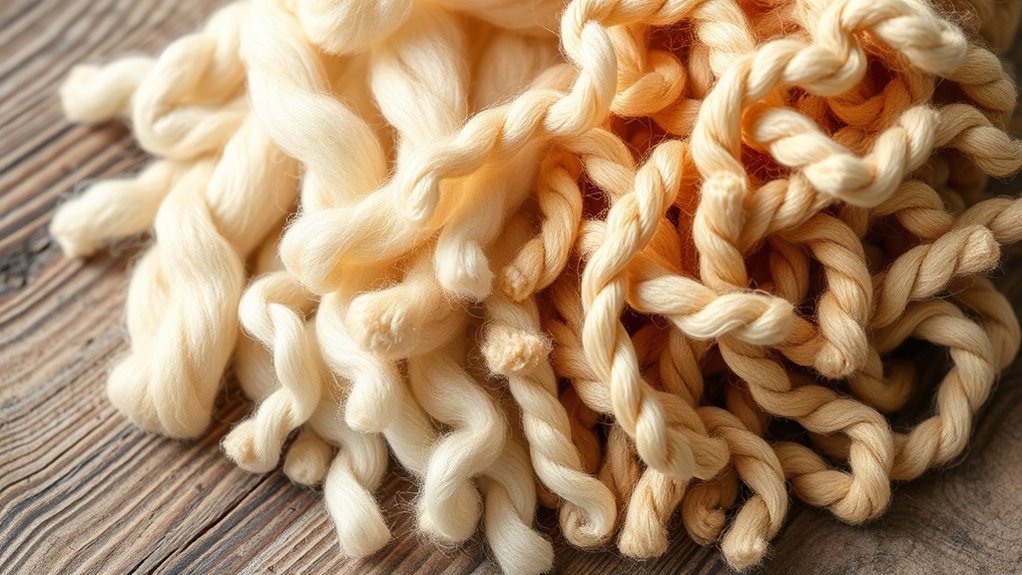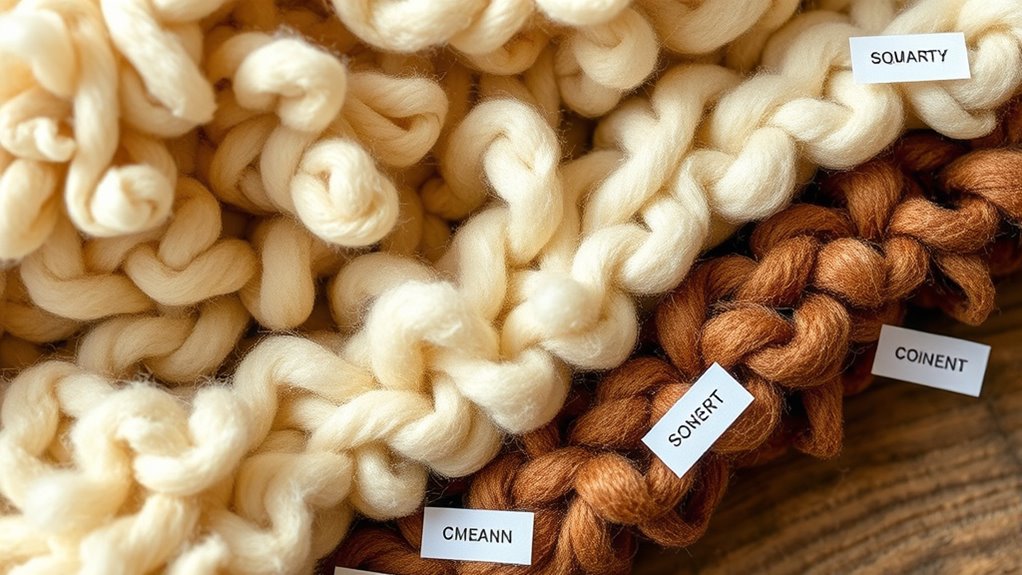Understanding wool’s types, grades, and warmth factors helps you choose the best for your needs. Finer fibers like Merino are softer and warmer, often from ethically raised sheep, while coarser wool offers durability. Wool quality varies by grading, influencing softness, insulation, and appearance. Sustainable sourcing also impacts its eco-friendliness and long-lasting comfort. Keep exploring to discover how different wool options can suit your lifestyle and how eco-conscious practices enhance their benefits.
Key Takeaways
- Different wool types, like Merino and Cashmere, vary in softness, fiber fineness, and insulating properties.
- Wool grades range from fine to coarse, influencing softness, durability, and suitability for various garments.
- The warmth of wool depends on fiber thickness, density, and processing, with finer fibers providing better insulation.
- Sustainable sourcing and ethical practices enhance wool quality, softness, and environmental benefits.
- Proper fiber processing retains natural warmth and resilience, ensuring long-lasting, eco-friendly wool products.

Have you ever wondered why wool remains a popular choice for cold-weather clothing? The answer lies in its unique combination of natural properties and the way it’s processed. Wool’s appeal starts with fiber processing, which transforms raw fleece into soft, wearable textiles. Skilled fiber processing involves carefully cleaning, carding, and spinning the wool to enhance its natural qualities while removing impurities. This process ensures that the finished product is comfortable, resilient, and capable of retaining warmth even when damp. More importantly, many wool producers now emphasize sustainable sourcing, which means they prioritize environmentally friendly practices and ethical treatment of sheep. By choosing wool from sustainable sources, you’re supporting a product that’s renewable, biodegradable, and produced with minimal ecological impact.
Understanding fiber processing is key to appreciating wool’s versatility. Once the raw fleece is shorn from the sheep, it undergoes washing to remove dirt, grease, and impurities—this is called scouring. The clean fiber is then carded, aligning the fibers into a continuous web, which makes spinning easier and results in a smoother yarn. Modern fiber processing often involves eco-conscious methods, like using biodegradable detergents and recycling water, to reduce environmental footprint. This attention to sustainable sourcing means that the wool you wear isn’t just warm and durable but also produced responsibly. As a consumer, choosing wool from brands that prioritize sustainable sourcing assures you’re supporting eco-friendly practices, from ethical sheep husbandry to environmentally conscious processing.
The quality and warmth of wool depend heavily on its fiber processing and sourcing. High-quality wool, such as Merino, comes from sheep raised under strict standards that emphasize sustainable practices. These standards not only ensure the welfare of the animals but also focus on maintaining healthy ecosystems and reducing chemical use. When wool is processed with sustainability in mind, it retains its natural insulation properties and durability longer, making it a smart investment for cold climates. It’s also worth noting that sustainable sourcing can influence the softness and appearance of the finished product, as ethically raised sheep often produce finer, more desirable fibers.
Frequently Asked Questions
How Does Wool Compare to Synthetic Fibers in Durability?
Wool generally offers better fiber resilience and wear resistance compared to synthetic fibers. You’ll find that wool can stretch and recover without losing its shape, making it more durable over time. Synthetic fibers may resist moisture and stains better, but they often break down faster under constant friction or repeated washing. So, if you’re looking for long-lasting wear, wool’s natural durability often outperforms synthetic options.
Can Wool Be Ethically Sourced and Environmentally Friendly?
Yes, wool can be ethically sourced and eco-friendly when you choose brands committed to sustainable wool practices. Look for certifications like Responsible Wool Standard or ZQ Merino, which guarantee animal welfare and environmental responsibility. By supporting companies that prioritize eco-friendly practices, you help reduce environmental impact and promote sustainable wool. This way, you get warm, high-quality wool while making environmentally conscious choices that benefit the planet.
What Maintenance Is Required to Prolong Wool Clothing Lifespan?
Ever wondered how to keep your wool clothing looking new? Proper wool care involves gentle washing, preferably by hand or on a delicate cycle with cold water. Always use mild detergent and avoid bleach. To maintain its shape, lay your wool flat to dry, avoiding direct sunlight. Regular maintenance tips like brushing with a soft brush and storing properly will prolong its lifespan. Isn’t it worth the effort for lasting warmth and comfort?
Are There Allergy Concerns With Wearing Wool?
You might experience allergy symptoms if you have wool sensitivity, as some people react to lanolin or other proteins in wool. If you notice itching, redness, or respiratory issues, it’s best to avoid wearing wool or choose hypoallergenic options. Always check labels for wool content, and consider testing a small patch first. Wearing a breathable liner can also help reduce allergy symptoms and make wool more comfortable.
How Does Climate Change Impact Wool Production and Quality?
Climate change affects wool production by shifting weather patterns, making climate adaptation essential for sheep farmers. Rising temperatures and unpredictable weather can reduce wool quality and quantity, challenging wool sustainability. You might notice inconsistent fiber strength or fineness, which impacts the softness and warmth of wool products. To guarantee a steady supply, farmers need to adopt sustainable practices that mitigate climate impacts, promoting resilient wool production for the future.
Conclusion
Now that you know the types, grades, and warmth factors of wool, you’re ready to make smarter choices. Whether you seek comfort, durability, or style, understanding wool helps you select what’s best for you. Embrace the versatility of wool, appreciate its natural qualities, and enjoy its timeless appeal. With this knowledge, you’ll confidently choose wool that keeps you warm, feels great, and lasts long—because knowing your wool makes all the difference.








